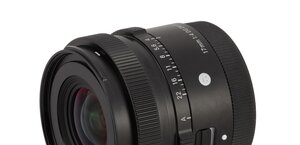Olympus M.Zuiko Digital 300 mm f/4.0 ED IS PRO
4. Image resolution
Let’s glance at the graph below and compare the results of the Olympus in the frame centre and on the edge of the frame.
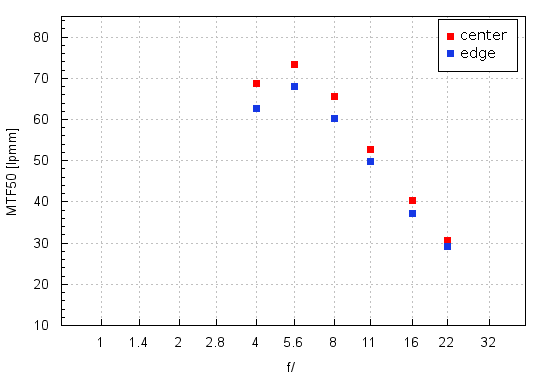
Please Support UsIf you enjoy our reviews and articles, and you want us to continue our work please, support our website by donating through PayPal. The funds are going to be used for paying our editorial team, renting servers, and equipping our testing studio; only that way we will be able to continue providing you interesting content for free. |
- - - - - - - - - - - - - - - - - - - - - - - - - - - - - - - - - - - - - - - - - - - - - - - -
Already at the maximum relative aperture the Olympus 4/300 is able to get to almost 70 lpmm; on stopping down the aperture to f/5.6 that value even improves, increasing to over 73 lpmm. It is an excellent level, allowing you to take exceptionally sharp photos.
Grumblers can say that the level of over 80 lpmm reached by the best primes is still unavailable but you should keep in mind that those record values were obtained by f/2.8 and f/4.0 apertures. The Olympus doesn’t have f/2.8; the f/4.0 aperture is actually its maximum relative aperture where optical aberrations still influence the quality of images. However already by f/5.6 you get the proof how well these aberrations have been corrected – the resolution result at that place, within the margin of error, is exactly the same as the resolution of the sharpest primes. It means that by f/5.6 the Olympus practically turns into a diffraction-limited lens, with all optical aberrations reduced to the bare minimum. Such a performance should be definitely praised. It’s enough to say it would be difficult to find another lens among those we’ve tested so far which, after stopping down by 1 EV stop, reduces most of optical aberrations so efficiently.
The performance on the edge of the frame should also be described in superlatives only. The results are lower than those in the centre but only slightly so. What’s important, even at the maximum relative aperture the MTFs reach 63 lpmm so the quality of images is good.
A Micro 4/3 system1.4x tele-converter has been available for a while; it would be such a shame not to check how the tested Olympus performs when attached to it. An appropriate graph with the resolution results you can find below.
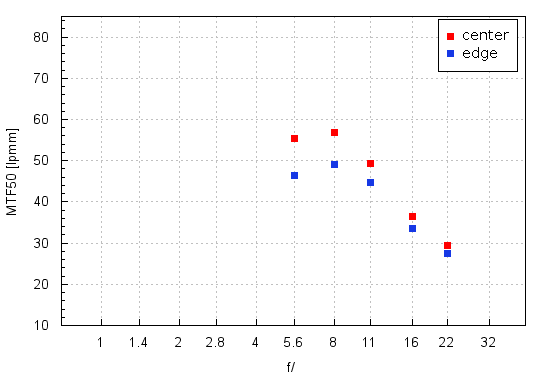
Here we encounter the same problems we tackled in our quite long introductiory chapter of the Panaleica 100-400 mm test. The maximum relative aperture of the Olympus 4/300 plus the tele-converter 1.4x amounts to f/5.6. In order to crop optical aberrations out of the frame it has to be stopped down to at least 1 EV. It means that even if the performance of such a combination of devices was very good it still would be difficult to get to a level of 60 lpmm.
Record values are not possible here but the performance of the optics should still be assessed positively. Even at the maximum relative aperture the MTFs are able to exceed 55 lpmm and they increase when you stop the aperture down by about 1 EV. It’s worth emphasizing how much more the 400 mm focal length of a fixed focus lens (even if limited by a tele-converter) is able to deliver compared to e.g. the same focal length of the Panaleica 100-400 mm, tested by us not so long ago. The fact that it was a bit slower zoom lens makes all the difference.
By way of digression: after publishing our Panaleica 100-400 mm test we found out our results at the longest focal lengths have been questioned on many foreign websites. It was claimed that they were heavily understated because of vibrations of the mechanical shutter and it was suggested that a Panasonic body with an electronic shutter would make them higher. It wasn’t exactly true. Having very strong lamps in our editorial office we were able to reduce the exposure times even to 1/1000-1/2000 sec. and additionally we used an “anti-shock” option with a value as high as15 seconds. The Olympus 4/300 test is the next proof we were right. This lens and the Panaleica were tested by us in the same conditions and yet here we had no problems whatsoever to reach much higher result, with the lens becoming diffraction-limited already near f/5.6. If the Panaleica had been corrected in a perfect way it would have fared like the Olympus at the combination of the f/5.6 aperture and the 300 mm focal length. Unfortunately it wasn’t the case because the Panaleica is a weaker instrument, “choked” by both its optical aberrations and the diffraction. The type of shutter used in the test seems to be of marginal significance.
At the end of this chapter traditionally we present crops taken from photos of our resolution testing chart saved as JPEG along with RAW files we used for the analysis above.
| Olympus E-PL1, JPEG, 300 mm, f/4.0 |
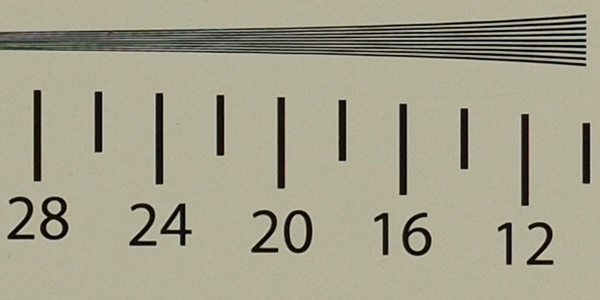 |
| Olympus E-PL1, JPEG, 300 mm, f/5.6 |
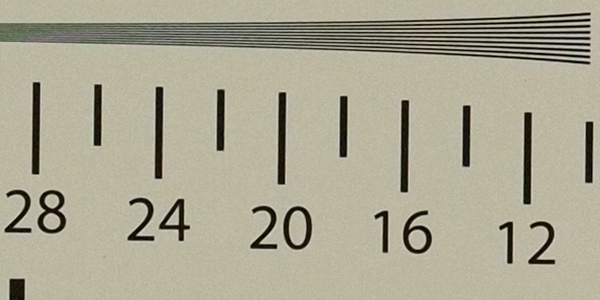 |





